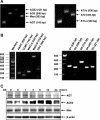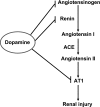Intrarenal dopamine modulates progressive angiotensin II-mediated renal injury
- PMID: 22169008
- PMCID: PMC3311314
- DOI: 10.1152/ajprenal.00583.2011
Intrarenal dopamine modulates progressive angiotensin II-mediated renal injury
Abstract
It is well-recognized that excessive angiotensin II (ANG II) can mediate progressive renal injury. Previous studies by us and others have indicated that dopamine may modulate actions of ANG II in the kidney. The current studies investigated whether altering intrarenal dopamine levels affected ANG II-mediated renal fibrosis. We utilized a model of increased intrarenal dopamine, catechol-O-methyl-transferase knockout (COMT KO) mice, which have increased kidney dopamine levels due to deletion of a major intrarenal dopamine-metabolizing enzyme. In wild-type mice, chronic ANG II infusion increased renal expression of both of the major dopamine-metabolizing enzymes, COMT and monoamine oxidase. After 8 wk of ANG II infusion, there were no significant differences in blood pressure between wild-type and COMT KO mice. Compared with wild-type, COMT KO mice had decreased albuminuria and tubulointerstitial injury. In response to ANG II infusion, there was decreased expression of both glomerular and tubulointerstitial injury markers (fibronectin, connective tissue growth factor, fibroblast-specific protein-1, collagen I, podocyte vascular endothelial growth factor) in COMT KO mice. We recently reported that ANG II-mediated tubulointerstitial fibrosis is mediated by src-dependent epidermal growth factor receptor (EGFR) activation. In aromatic l-amino acid decarboxylase knockout (AADC KO) mice, a model of intrarenal dopamine deficiency due to selective proximal tubule AADC deletion, which inhibits intrarenal dopamine synthesis, ANG II infusion further increased expression of p-src and pTyr845-EGFR. In contrast, their expression was markedly attenuated in COMT KO mice. These results demonstrate a role for intrarenal dopamine to buffer the detrimental effects of ANG II upon the kidney.
Figures








Similar articles
-
Intrarenal dopamine inhibits progression of diabetic nephropathy.Diabetes. 2012 Oct;61(10):2575-84. doi: 10.2337/db12-0046. Epub 2012 Jun 11. Diabetes. 2012. PMID: 22688335 Free PMC article.
-
Role of epoxyeicosatrienoic acids (EETs) in mediation of dopamine's effects in the kidney.Am J Physiol Renal Physiol. 2013 Dec 15;305(12):F1680-6. doi: 10.1152/ajprenal.00409.2013. Epub 2013 Oct 23. Am J Physiol Renal Physiol. 2013. PMID: 24154693 Free PMC article.
-
Intrarenal dopamine deficiency leads to hypertension and decreased longevity in mice.J Clin Invest. 2011 Jul;121(7):2845-54. doi: 10.1172/JCI57324. Epub 2011 Jun 23. J Clin Invest. 2011. PMID: 21701066 Free PMC article.
-
Angiotensin II and its receptors in the diabetic kidney.Am J Kidney Dis. 2000 Sep;36(3):449-67. doi: 10.1053/ajkd.2000.16192. Am J Kidney Dis. 2000. PMID: 10977776 Review.
-
Evidence for a functional intracellular angiotensin system in the proximal tubule of the kidney.Am J Physiol Regul Integr Comp Physiol. 2012 Mar 1;302(5):R494-509. doi: 10.1152/ajpregu.00487.2011. Epub 2011 Dec 14. Am J Physiol Regul Integr Comp Physiol. 2012. PMID: 22170616 Free PMC article. Review.
Cited by
-
Involvement of dopaminergic signaling in the cross talk between the renin-angiotensin system and inflammation.Semin Immunopathol. 2020 Dec;42(6):681-696. doi: 10.1007/s00281-020-00819-8. Epub 2020 Sep 30. Semin Immunopathol. 2020. PMID: 32997225 Free PMC article. Review.
-
Aromatic L-amino acid decarboxylase (AADC) is crucial for brain development and motor functions.PLoS One. 2013 Aug 5;8(8):e71741. doi: 10.1371/journal.pone.0071741. Print 2013. PLoS One. 2013. PMID: 23940784 Free PMC article.
-
The role of the brain renin-angiotensin system in Parkinson´s disease.Transl Neurodegener. 2024 Apr 15;13(1):22. doi: 10.1186/s40035-024-00410-3. Transl Neurodegener. 2024. PMID: 38622720 Free PMC article. Review.
-
Congenital eyelid ptosis, decreased glomerular filtration, and orthostatic hypotension: Answers.Pediatr Nephrol. 2017 Jul;32(7):1171-1174. doi: 10.1007/s00467-016-3515-1. Epub 2016 Nov 17. Pediatr Nephrol. 2017. PMID: 27858196 Free PMC article. No abstract available.
-
Cellular mechanisms of tissue fibrosis. 3. Novel mechanisms of kidney fibrosis.Am J Physiol Cell Physiol. 2013 Apr 1;304(7):C591-603. doi: 10.1152/ajpcell.00414.2012. Epub 2013 Jan 16. Am J Physiol Cell Physiol. 2013. PMID: 23325411 Free PMC article. Review.
References
-
- Aperia AC. Intrarenal dopamine: a key signal in the interactive regulation of sodium metabolism. Annu Rev Physiol 62: 621–647, 2000 - PubMed
-
- Armando I, Wang X, Villar VA, Jones JE, Asico LD, Escano C, Jose PA. Reactive oxygen species-dependent hypertension in dopamine D2 receptor-deficient mice. Hypertension 49: 672–678, 2007 - PubMed
-
- Berndt TJ, Liang M, Tyce GM, Knox FG. Intrarenal serotonin, dopamine, and phosphate handling in remnant kidneys. Kidney Int 59: 625–630, 2001 - PubMed
-
- Carey RM. Theodore Cooper Lecture: renal dopamine system: paracrine regulator of sodium homeostasis and blood pressure. Hypertension 38: 297–302, 2001 - PubMed
-
- Chen CJ, Apparsundaram S, Lokhandwala MF. Intrarenally produced angiotensin II opposes the natriuretic action of the dopamine-1 receptor agonist fenoldopam in rats. J Pharmacol Exp Ther 256: 486–491, 1991 - PubMed
Publication types
MeSH terms
Substances
Grants and funding
LinkOut - more resources
Full Text Sources
Molecular Biology Databases
Research Materials
Miscellaneous

